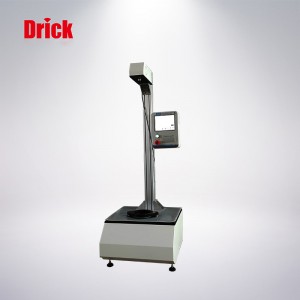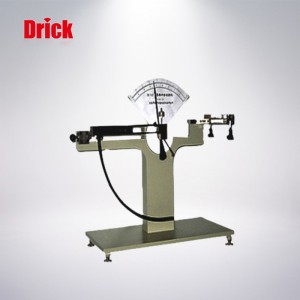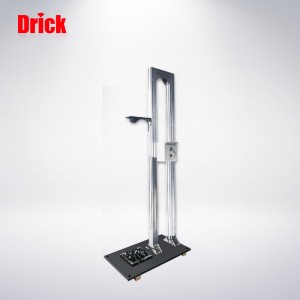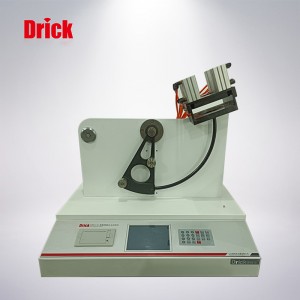DRK135 Falling Dart Impact Tester
The DRK135 falling dart impact tester is used to determine the impact mass and energy of 50% of the plastic film or flakes under the impact of a given height of free falling darts with a thickness of less than 1mm.
The dart drop test often chooses the step method to carry out, and the step method is divided into the dart drop impact A method and the B method.
The difference between the two: the diameter of the dart head, the material and the height of the drop are different. Generally speaking, Method A is suitable for materials with impact damage mass of 50g~2000g. Method B is suitable for materials with an impact damage mass of 300g to 2000g.
Among them, the cascade method of GB/T 9639 and ISO 7765 are equivalent methods.
Method A: The diameter of the dart head is 38±1mm. The material of the dart head is made of smooth and polished aluminum, phenolic plastic or other low-density materials with similar hardness. The drop height is 0.66±0.01m.
Method B: The diameter of the falling dart head is 50±1mm. The material of the dart head is made of smooth, polished stainless steel or other materials with similar hardness. The falling height is 1.50 ±0.01m. In ASTM D1709, the diameter of the dart head of method A and method B are 38.1±0.13mm and 50.8±0.13mm, respectively.
Features
1. The machine model is novel, the operation design is considerate, and the national standards and international standards are compatible at the same time.
2. Test method A, B dual mode.
3. Test data The test process is intelligent, which greatly improves work efficiency.
4. The sample is pneumatically tightened and released, which reduces the experimental error and test time.
5. Data parameter system LCD display.
Applications
Films and sheets are suitable for impact resistance testing of plastic films, sheets and composite films with a thickness of less than 1mm. Such as PE cling film, stretch film, PET sheet, food packaging bags of various structures, heavy packaging bags and other aluminum foil, aluminum-plastic composite film, suitable for impact resistance test of aluminum foil, aluminum-plastic composite film, paper, cardboard test It is used to test the impact resistance of paper and cardboard.
technical standard. At the beginning of the test, first select the test method, estimate an initial mass and Δm value, and perform the test. If the first sample is broken, use a weight Δm to reduce the falling body mass; if the first sample is not broken, use a weight Δm to increase The quality of the falling body is tested accordingly. In short, the use of weights to reduce or increase the mass of the falling body depends on whether the previous sample is damaged. After 20 specimens are tested, calculate the total number of damage N. If N is equal to 10, the test is completed; if N is less than 10, after replenishing the specimen, continue the test until N is equal to 10; if N is greater than 10, after replenishing the specimen, continue the test until The total number of undamaged is equal to 10, and finally the impact result is automatically calculated by the system. The instrument complies with GB9639, ASTM D1709, JISK7124 and other relevant standards and regulations.
Product parameter
| Project | Parameter |
| Measurement Methods | Method A, Method B (choose one of the two, can also be realized at the same time) |
| Test Range | Method A: 50~2000g Method B: 300~2000g |
| Test Range | Test Accuracy: 0.1g (0.1J) |
| Specimen Clamping | electric |
| Specimen Size | >150mm×150mm |
| Power Supply | AC 220V±5% 50Hz |
| Net Weight | About 65kg |
Product configuration
Standard configuration: A method configuration, micro printer.
Optional purchase parts: Method B configuration, professional software, communication cable.
Note: Due to technological progress, the information will be changed without notice. The product is subject to the actual product in the later period.
Products categories
-

Phone
-

E-mail
-

Whatsapp
-

Top





